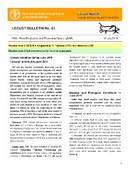General situation from November 2019 to February 2020 Forecast until late March 2020
Natural cycles of the three locust species – Italian Locust (CIT), Migratory Locust (LMI) and Moroccan Locust (DMA) ended in late summer/early autumn in all countries with eggs laid in the soil, where they overwinter (embryonic diapause). During the forecast period, no development is expected as no hatching will occur....
General situation during August 2019 Forecast until mid-October 2019
Italian Locust (CIT) mating and egg-laying continued in Armenia, Azerbaijan, Georgia, Kazakhstan, Kyrgyzstan, Russian Federation, Tajikistan and Uzbekistan. Migratory Locust (LMI) mating and egg
laying continued in Kazakhstan, Russian Federation and Uzbekistan. During the forecast period, locusts will complete their natural cycle in most areas. Control operations ended in all countries;...
General situation during July 2019 Forecast until mid-September 2019
Hot and dry weather accelerated die-off of the Moroccan Locust (DMA) everywhere, with some limited swarm flights still occurring in Tajikistan. Italian Locust (CIT) and Migratory Locust (LMI) hopper development completed, followed by mating and egg-laying. Control operations were winding down in most countries except for Kazakhstan and Russian Federation....
General situation during June 2019 Forecast until mid-August 2019
Hot and dry weather accelerated Moroccan Locust (DMA) development and late-instar hoppers and adults prevailed in its populations. In the southern areas of Central Asia (CA) its life cycle came to an end while swarm flights, mating and egg-laying continued elsewhere. During the forecast period, DMA egg-laying will subside and...
General situation during May 2019 Forecast until mid-July 2019
Moroccan Locust (DMA) hopper development was in progress in Kazakhstan and the Russian Federation while it was coming to an end in Azerbaijan, Georgia as well as in southern Central Asian (CA) countries where fledging,...






